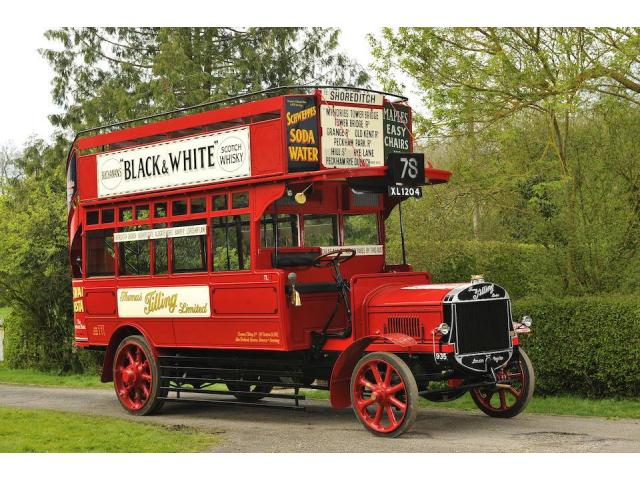1922 Tilling-Stevens TS3A Open Top Double Deck Bus
- Brand: Tilling-Stevens
1922 Tilling-Stevens TS3A Open Top Double Deck Bus
With its roots dating back to 1847, when young Thomas Tilling established a jobmaster's business in London and began running a horse-drawn omnibus service three years later, Thomas Tilling Limited was incorporated in 1897, with an issued share capital of £400,000 and a stable of around 4000 horses. Tilling is credited as the first operator to run omnibuses to a set timetable using fixed stops. The firm bought its first motor buses a fleet of 20 Milnes-Daimler 34-seater open-top double-deckers operating out of the Peckham area in 1904-05, and in 1911 introduced the first of a new type of vehicle the hybrid petrol-electric TTA1 to their fleet of motor buses. The advantage of the electric transmission, manufactured by the W.A. Stevens works in Maidstone, Kent, was that it used a petrol engine to drive a generator that supplied current to a motor driving the wheels, thus eliminating the need to change gear and making it simple to drive. It was an early form of "two-pedal control". In those transitional days, it was believed that horse bus drivers would find it easier to learn to drive a petrol-electric than cope with a clutch and crash gears. Tilling was offered the patent for the petrol-electric system by its designer Percy Frost-Smith for £3000 and the purchase was financed for Tilling by the London General Omnibus Company, with whom Tilling had had a "pooling agreement" since 1909.
A new company called Tilling-Stevens was formed, and by 1921 the Thomas Tilling company had 150 motor buses operating on the streets of London. In 1922 the company ordered 166 new Tilling-Stevens TSA3 petrol-electric bus chassis from the Maidstone factory. The TS3A was a bigger bus than the TTA1 it replaced, with a 48-seat body carrying 22 passengers inside and 26 outside. Power came from a 5722cc pair-cast four-cylinder engine rated at 40 hp linked by a laminated spring connection to a compound wound generator supplying current through insulated cables to a series-wound motor coupled to an overhead worm rear axle by a cardan shaft.
Promoted as "the vehicle without gears or clutch", the TS3A had a chassis price of £1165; among the other claimed advantages of the petrol-electric system were low maintenance costs and high tyre mileage, plus "many other telling points too numerous to mention". Intriguingly, road speed was not governed by engine speed, for on a level surface the engine and dynamo could be running at a low speed but developing sufficient electrical power to turn the electric motor at a higher speed. This actual Tilling-Stevens was delivered from Maidstone to the Thomas Tilling garage in Catford, London, in June 1922 and fitted with a 48-seater (22 inside, 26 outside) open-top body built on the trussed-girder principle for extra strength and freedom from vibration by Tilling's coachworks in Wren Road, Camberwell. It was registered XL-1204 and given the fleet number 935.
It remained in service until 1931, when it was sold to a dealer named W.H. Cooper of Bethnal Green. London. As the last known surviving example of the hundreds of Tilling-Steven TS3A buses operated in London by Thomas Tilling during the 1920s, this is a most important historic commercial vehicle.
Descriptions and pictures by ruotevecchie
| Specification | |
| Production Start | 1922 |
| Country of origin | Great Britain |









































